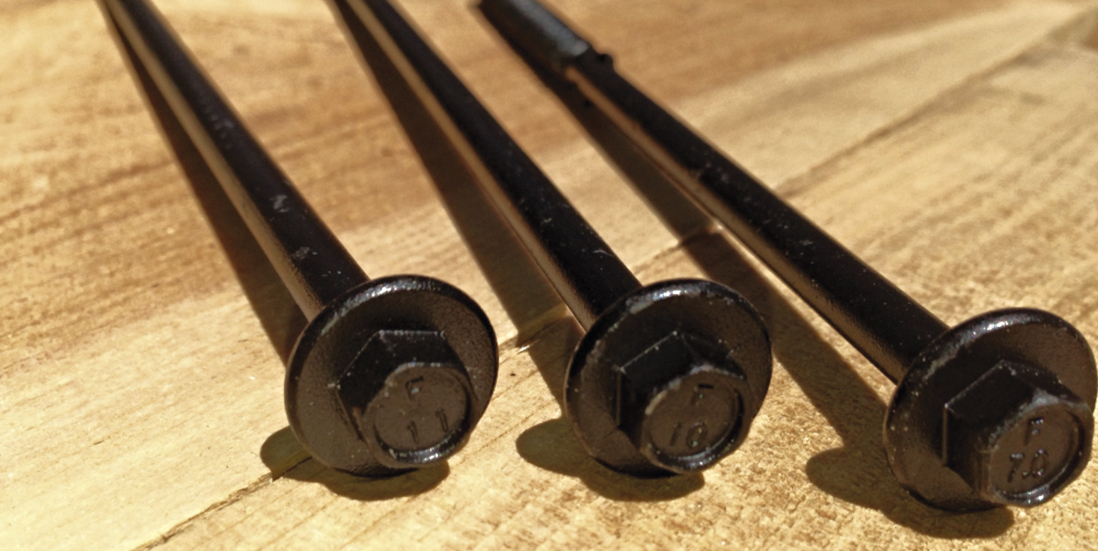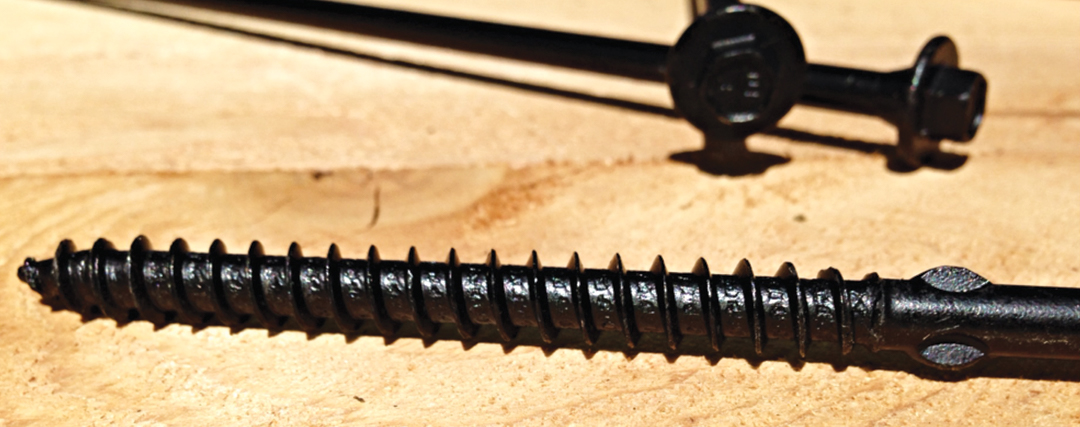To better serve the builder/customer, there must be something better. The fastener we were looking for had to add value to the customer, and this can be accomplished in multiple ways. The best fastener we found lessens the biggest costs - reduces labor cost, speeds up the installation process, and reduces the need for specialized tools. You also must have a product that performs and meets the expectations of the user, and to do this, Perma-Chink Systems chose the Log Boss log and timber fastener to meet the demanding needs of builders and contractors.
Log Boss Design Benefits
The design of the fastener is very critical to overall performance and ease of use. At the request of many of our customers, we’ve redesigned the head for better counter-sinking and uses a 5/16” hex head driver. The wings reduce the friction between the wood and the shank, clearing out the splinters created as the fastener pulls down into the wood. This reduces the torque required to set the fastener into place. Reducing the torque decreases the strain around the wood fibers, which increases the holding power of the wood fibers between the threads. The result is much greater pullout values by eliminating thread strip out.
One of the most outstanding features of the fastener is the ‘wings’ above the threads. The goal was not to disturb the thread holding value but to drive the fasteners into timbers with less torque requirements. The wings act as a reamer, allowing the shank to rotate much easier with less friction in the log. Without wings, the wood fibers bind up on the shank, seizing it to the point it becomes almost impossible to complete the required depth. It also often results in fasteners breaking off just above the threads, which adds wasted time to the project.
 Another great feature of the Log Boss is the special rust-resistant coating applied to all fasteners, reducing the chances for rust to discolor the logs during extended exposure times on the jobsite. There is also a special lubricant applied to the fastener to aid in driving operations. Log Boss can be driven with an 18-volt cordless drill, but for best results we recommend the use of a ½” low rpm drill for optimum driving performance.
Another great feature of the Log Boss is the special rust-resistant coating applied to all fasteners, reducing the chances for rust to discolor the logs during extended exposure times on the jobsite. There is also a special lubricant applied to the fastener to aid in driving operations. Log Boss can be driven with an 18-volt cordless drill, but for best results we recommend the use of a ½” low rpm drill for optimum driving performance.
Log Boss fasteners are packaged in jobsite-friendly containers that resist damage from abuse and moisture. All sizes below 14” are packaged in plastic pails containing 250 fasteners and a drive bit.
Picking The Correct Log Boss
Now, how do you determine what size fastener that you need to use and what are the basics?
First, it is important to follow the log manufacturer’s recommendations as to the placement of the fasteners. The length of the fastener is critical to achieve the best performance. The selected fastener length must allow the threads to pass entirely through the first log, and thread into the second. The reason behind this is simple: in the event log movement happens, the log must be anchored to the bottom log, with the head providing pull-down pressure on the top log. It matters not if the screw is a little longer than you need, but make sure the threads will pass clear through the first log.
If you encounter a knot while installing the fastener, you will need to apply more torque to seat properly. It is a good idea to back the fastener out and move it over a little to avoid the knot. Another event that sometime occurs is the fastener may follow twisted grain and come out the side of the log.
So, if you want a fastener with maximum holding power and superior strength with less work, Log Boss is the answer. These fasteners were specifically designed by Perma-Chink Systems for the construction of log and timber structures. Their 3” long thread provides the grip necessary for pulling even the most difficult logs into place while the larger shank diameter increases the overall strength and pulling power.
Log Boss Benefits
Pre-drilling is not required
No washer needed. Drive it one time and forget it!
Flat head design easily counter sinks with maximum pulling power
Replaces the need for spikes or lag bolts
Lubrication coating speeds set time
Large threads prevent stripping out
Teflon® coating exceeds FM 4470 corrosion standards
Ask us for a complete line of wood-to-wood, code-approved fasteners for decks, ledger boards, and large timber applications.
